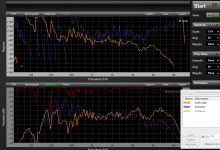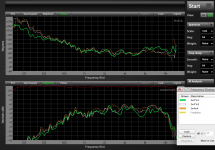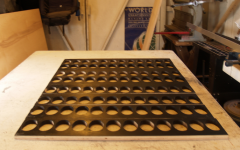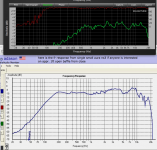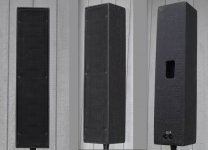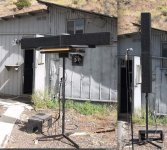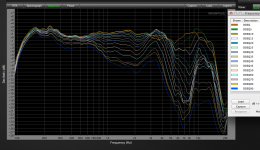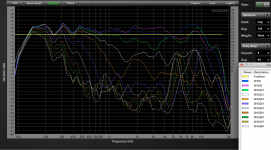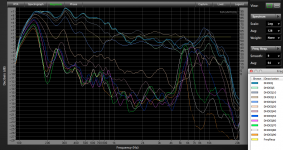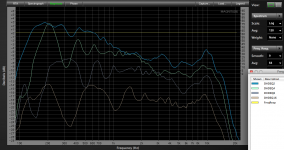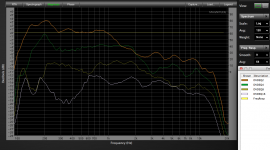As a preliminary for this project:
HyperboLine ™ new Player in the Old Game
I tested the JAMO 30466/30462 2-1/2" X 4" Shielded Speaker, from Parts Express, part #299-919 in a small line array.
I won't go in to a long description of the Dirty Dozen sonic attributes, as I'm not a fan of line arrays for home use in general. That said, for under $20 for two dozen speakers, this line is hard to beat for non critical listening.
It would also make a cute "Bose Killer" PA for musicians/house of worship on a budget.
Interior dimensions of the cabinet were 4.25 x 2 x 31.875 inches, using 3/4 inch plywood with 3/4" dividers between each series pair of speakers. The 12 drivers were wired in three 24 ohm series pairs (3 x 8 ohm) then the four paralleled, for a nominal cabinet impedance of 6 ohms (24/4=6). Sensitivity of the individual speakers is 83 dB 1 watt one meter, the Dirty Dozen is around 92 dB.
New test results with the speakers in a ported cabinet are in post #6.
The speakers individually can handle more than 20 watts sine wave for a short period of time, but distort with more than their rated input of 10 watts. With a few watts the the Dirty Dozen can get loud, much over 120 watts is not going to improve things.
The buyout speakers are incredibly cheap, but don't sound bad.
They do require a very precise hole cut, and since they are oval, a special router jig must be made unless you are extremely good (and incredibly patient) with a jig saw.Took a me a half dozen tries to make a decent template for the router. The 31.875 inch baffle height is just barely tall enough for 12 drivers with their edges touching.
The speakers have the "-" terminal wired to the frame, that wire must be cut or the frames touching will screw up the series parallel wiring. The speaker frames bend easily, final screwing should be carefully done by hand or the bent frame will result in a buzzing speaker. Fortunately, the speakers can be also be bent back in shape, the few "buzzers"(out of 96) I did not seat properly the first time were corrected by re-bending and re-seating.
Out of 120 speakers, four arrived dead, two had the color coding reversed, and the color coding of the wires soldered to the speakers is black for +, white for -, opposite from the usual convention.
Parts Express sent out replacements for the dead units. The speaker quality control was not bad, the frequency response of the line array is fairly representative of the average units. m The "Dirty D Rag" chart shows the response of three of the speakers, measured at about 1 foot, the back loosely sealed with a towel.
The unit labeled 2x4"in 1 (green trace) is the more usual, 2x4"in2 and 2x4"in4 are better than average.
8 out of the 120 tested showed this better than average response, they did not have as deep a dip at 8 kHz as the rest.
Most of the very high frequency output is emitted from the tiny dust cap, making for better HF response than many round speakers of the same height, and the additional cone area of the 4 inch width make the response strong to 200 Hz. The 4" speaker width is responsible for some erratic frequency response on and off-axis in the 8kHz region, but the rest of the response is fairly uniform from nearly omnidirectional at 200 Hz to about 75 degree (-6 dB points) at 16 K.
The polar charts below were done indoors at only one meter. The charts in in post #6 give a better idea of the polar response.
The drooping HF response and large peak centered at about 320 Hz response is influenced by the short measurement distance and the room, as can be seen in the chart 2x4lineIn, taken at 29 feet indoors, and 2x4Line dd, at 40 foot outdoors.
Cross over a woofer beneath, and they are good to go.
Use EQ to correct the major dips and peaks if you are picky.
A floor to ceiling line array costs less than $100 for a pair (assuming your ceiling height is less than 12.5 feet, not including cabinet costs) including a pound of solder.
Have fun!
Art
HyperboLine ™ new Player in the Old Game
I tested the JAMO 30466/30462 2-1/2" X 4" Shielded Speaker, from Parts Express, part #299-919 in a small line array.
I won't go in to a long description of the Dirty Dozen sonic attributes, as I'm not a fan of line arrays for home use in general. That said, for under $20 for two dozen speakers, this line is hard to beat for non critical listening.
It would also make a cute "Bose Killer" PA for musicians/house of worship on a budget.
Interior dimensions of the cabinet were 4.25 x 2 x 31.875 inches, using 3/4 inch plywood with 3/4" dividers between each series pair of speakers. The 12 drivers were wired in three 24 ohm series pairs (3 x 8 ohm) then the four paralleled, for a nominal cabinet impedance of 6 ohms (24/4=6). Sensitivity of the individual speakers is 83 dB 1 watt one meter, the Dirty Dozen is around 92 dB.
New test results with the speakers in a ported cabinet are in post #6.
The speakers individually can handle more than 20 watts sine wave for a short period of time, but distort with more than their rated input of 10 watts. With a few watts the the Dirty Dozen can get loud, much over 120 watts is not going to improve things.
The buyout speakers are incredibly cheap, but don't sound bad.
They do require a very precise hole cut, and since they are oval, a special router jig must be made unless you are extremely good (and incredibly patient) with a jig saw.Took a me a half dozen tries to make a decent template for the router. The 31.875 inch baffle height is just barely tall enough for 12 drivers with their edges touching.
The speakers have the "-" terminal wired to the frame, that wire must be cut or the frames touching will screw up the series parallel wiring. The speaker frames bend easily, final screwing should be carefully done by hand or the bent frame will result in a buzzing speaker. Fortunately, the speakers can be also be bent back in shape, the few "buzzers"(out of 96) I did not seat properly the first time were corrected by re-bending and re-seating.
Out of 120 speakers, four arrived dead, two had the color coding reversed, and the color coding of the wires soldered to the speakers is black for +, white for -, opposite from the usual convention.
Parts Express sent out replacements for the dead units. The speaker quality control was not bad, the frequency response of the line array is fairly representative of the average units. m The "Dirty D Rag" chart shows the response of three of the speakers, measured at about 1 foot, the back loosely sealed with a towel.
The unit labeled 2x4"in 1 (green trace) is the more usual, 2x4"in2 and 2x4"in4 are better than average.
8 out of the 120 tested showed this better than average response, they did not have as deep a dip at 8 kHz as the rest.
Most of the very high frequency output is emitted from the tiny dust cap, making for better HF response than many round speakers of the same height, and the additional cone area of the 4 inch width make the response strong to 200 Hz. The 4" speaker width is responsible for some erratic frequency response on and off-axis in the 8kHz region, but the rest of the response is fairly uniform from nearly omnidirectional at 200 Hz to about 75 degree (-6 dB points) at 16 K.
The polar charts below were done indoors at only one meter. The charts in in post #6 give a better idea of the polar response.
The drooping HF response and large peak centered at about 320 Hz response is influenced by the short measurement distance and the room, as can be seen in the chart 2x4lineIn, taken at 29 feet indoors, and 2x4Line dd, at 40 foot outdoors.
Cross over a woofer beneath, and they are good to go.
Use EQ to correct the major dips and peaks if you are picky.
A floor to ceiling line array costs less than $100 for a pair (assuming your ceiling height is less than 12.5 feet, not including cabinet costs) including a pound of solder.
Have fun!
Art
Attachments
Last edited:
"Out of 120 speakers, four arrived dead, two had the color coding reversed..." some losses allowed (see my CBT thread)
there are those who believe cheap drivers give you cheap sound, (something like 50 crap speakers are 50 crappier sound or crap like that) but I do not believe so, I used $1 Aura drivers in CBT array and they sound fantastic...interestingly they measure similarly to yours, and I decided to add array of tweeters, that helped a lot, so I believe your array would benefit from adding tweeters too
working with oval drivers must be pain...
working with oval drivers must be pain...
The Aura NS3 drivers you used seem to be about -12 at 16 kHz and the response above 10 kHz ragged, the Jamo 2.5x4" are only about -3 at 16 kHz, with ragged response through most of the range 😀.I used $1 Aura drivers in CBT array and they sound fantastic...interestingly they measure similarly to yours, and I decided to add array of tweeters, that helped a lot, so I believe your array would benefit from adding tweeters too
working with oval drivers must be pain...
The top octave response is not the worst aspect of these drivers😉.
Once I finished a jig, wasn't too hard to deal with the oval drivers, but making the jig was a real pain- I could have cut 24 holes with a circle cutter in about the time it took making the jig.
Of course, if I would have used a smaller jig saw blade, might have only took me 2 tries instead of six to make a decent jig...
Art
Attachments
Last edited:
I have some Samsing oval speakers from Electronic Goldmine and some JVC oval speakers from a Parts Express buyout sale. I've been wanting to try something similar, using 16 drivers a side. I also picked up some of the tiny button tweers from Parts Express for a tweeter array, as I suspect the top end on either speaker is raggedy. I'll probably throw something together using foam core board first.
Dirty Dozen Redux
An update to the project, last winter finished a pair of cabinets using a rear bass reflex port to make the Dirty Dozen usable to around 110 Hz, so the subwoofer crossover frequency can now be low enough to not be easily locatable, so the subs can be put in more convenient locations. They also are now capable of vocal reinforcement without requiring subs, more useful for PA work. The port also serves as a carry handle.
Since the ability to use a pair on a single amp side was desired, the cabinets are wired with nominal impedance of 10.66 ohms (three parallel connections of series quads), the 1 watt one meter sensitivity measures around 94 dB midband in free space 2 dB better than the estimate based on the driver's rated sensitivity. The raw frequency response and port output show the very smooth response from 300-2000 Hz, and the stepped down port response about -7 dB, one cabinet is capable of 90 dB SPL reasonably clean response in the 110-160 Hz range at two meters. In an average living room, you can expect around 96-102 dB in the low end with about 75 watts per cabinet. In the upper range, where excursion is not a concern, a pair are capable of clean peaks of 106+ dB at 2 meters with around 200 watts per cabinet.
Outdoors, a pair can deliver an average of 90+ dB at 16 meters (52 feet). They sound quite good until pushed into thermal limiting, apparent when driving them to the limits of an amp capable of delivering 400 watt peaks. Horizontal dispersion is quite wide and uniform up to 2000 Hz, above that, it widens, then narrows, then goes back to around 90 degrees in the 9-16kHz range. Other than the beaming in the 8kHz range, the DD horizontal dispersion is quite good.
Vertical dispersion is more "interesting", the center to center distance between the 12 drivers is 29.5" (.76 meter) results in wide variation of off axis response, only remaining within a 6 dB range within around 20 degrees, 10 degrees up or down from center. The line length in general results in a progressively narrowing vertical pattern with 140 degrees (70 off axis) at -6 dB at 250 Hz. The pattern has exceptions, high frequency "fingers" that rise from 6 to 20 dB above the average off axis level. Depending on the array's distance from the floor or ceiling, the reflections of those peaks may result in increased or decreased level. By coincidence, those peaks are also in the range where the horizontal response narrows, in room response may be roughly "flat", but the timing of the problem range a bit disjointed, or in marketing speak, "spacious".
Using a pair of the Dirty Dozen to double the vertical length (two cabinet 24 driver C to C length is 63", 1.6 meter) drops the 140 degree -6 dB vertical dispersion from 250 Hz to 160 Hz, though increases the severity of the HF "fingers". The two meter measurement distance used for the DD x2 vertical polars is in the extreme near field of the line array, resulting in around a +6 dB summation increase in low frequency response, with no increase in the high frequency response over the single due to path length interference cancellation. As the listening distance increases, the LF drops at roughly 6 dB per doubling of distance (the usual inverse distance drop), while the HF exhibits progressively less interference, so drops at only about 3 dB per doubling while still within the near field, which in the case of the double Dirty Dozen transitions between 8 and 16 meters.
The response variation in LF vs. HF can be seen in the DD hx2 2m to 16m chart two cabinets horizontally supported with the center just under 2m off the ground. The mic and cabinet height results in "ground bounce" response peaks and dips visible (and audible) below 2000 Hz. Placing the cabinets vertically (the normal "line array" fashion) lessens the ground bounce effect, due to the more narrow vertical dispersion resulting in less ground "spill". The DD v x2 2m to 16m chart (two cabinets vertical, center at 2m off the ground) shows the ground bounce effect dropping from +/- 8 dB to only +/- 4dB. The EQ was adjusted to remove the 10kHz peak present in the previous test, though hotter, drier windier conditions made for less accurate response in the upper region than the first test done in the calm cool morning.
Art
An update to the project, last winter finished a pair of cabinets using a rear bass reflex port to make the Dirty Dozen usable to around 110 Hz, so the subwoofer crossover frequency can now be low enough to not be easily locatable, so the subs can be put in more convenient locations. They also are now capable of vocal reinforcement without requiring subs, more useful for PA work. The port also serves as a carry handle.
Since the ability to use a pair on a single amp side was desired, the cabinets are wired with nominal impedance of 10.66 ohms (three parallel connections of series quads), the 1 watt one meter sensitivity measures around 94 dB midband in free space 2 dB better than the estimate based on the driver's rated sensitivity. The raw frequency response and port output show the very smooth response from 300-2000 Hz, and the stepped down port response about -7 dB, one cabinet is capable of 90 dB SPL reasonably clean response in the 110-160 Hz range at two meters. In an average living room, you can expect around 96-102 dB in the low end with about 75 watts per cabinet. In the upper range, where excursion is not a concern, a pair are capable of clean peaks of 106+ dB at 2 meters with around 200 watts per cabinet.
Outdoors, a pair can deliver an average of 90+ dB at 16 meters (52 feet). They sound quite good until pushed into thermal limiting, apparent when driving them to the limits of an amp capable of delivering 400 watt peaks. Horizontal dispersion is quite wide and uniform up to 2000 Hz, above that, it widens, then narrows, then goes back to around 90 degrees in the 9-16kHz range. Other than the beaming in the 8kHz range, the DD horizontal dispersion is quite good.
Vertical dispersion is more "interesting", the center to center distance between the 12 drivers is 29.5" (.76 meter) results in wide variation of off axis response, only remaining within a 6 dB range within around 20 degrees, 10 degrees up or down from center. The line length in general results in a progressively narrowing vertical pattern with 140 degrees (70 off axis) at -6 dB at 250 Hz. The pattern has exceptions, high frequency "fingers" that rise from 6 to 20 dB above the average off axis level. Depending on the array's distance from the floor or ceiling, the reflections of those peaks may result in increased or decreased level. By coincidence, those peaks are also in the range where the horizontal response narrows, in room response may be roughly "flat", but the timing of the problem range a bit disjointed, or in marketing speak, "spacious".
Using a pair of the Dirty Dozen to double the vertical length (two cabinet 24 driver C to C length is 63", 1.6 meter) drops the 140 degree -6 dB vertical dispersion from 250 Hz to 160 Hz, though increases the severity of the HF "fingers". The two meter measurement distance used for the DD x2 vertical polars is in the extreme near field of the line array, resulting in around a +6 dB summation increase in low frequency response, with no increase in the high frequency response over the single due to path length interference cancellation. As the listening distance increases, the LF drops at roughly 6 dB per doubling of distance (the usual inverse distance drop), while the HF exhibits progressively less interference, so drops at only about 3 dB per doubling while still within the near field, which in the case of the double Dirty Dozen transitions between 8 and 16 meters.
The response variation in LF vs. HF can be seen in the DD hx2 2m to 16m chart two cabinets horizontally supported with the center just under 2m off the ground. The mic and cabinet height results in "ground bounce" response peaks and dips visible (and audible) below 2000 Hz. Placing the cabinets vertically (the normal "line array" fashion) lessens the ground bounce effect, due to the more narrow vertical dispersion resulting in less ground "spill". The DD v x2 2m to 16m chart (two cabinets vertical, center at 2m off the ground) shows the ground bounce effect dropping from +/- 8 dB to only +/- 4dB. The EQ was adjusted to remove the 10kHz peak present in the previous test, though hotter, drier windier conditions made for less accurate response in the upper region than the first test done in the calm cool morning.
Art
Attachments
Last edited:
- Status
- Not open for further replies.


